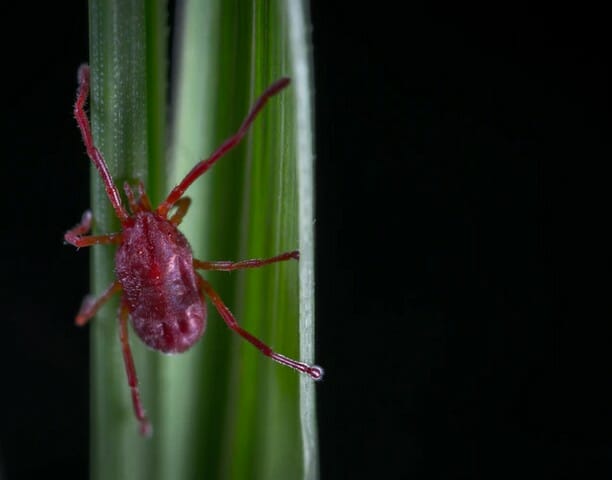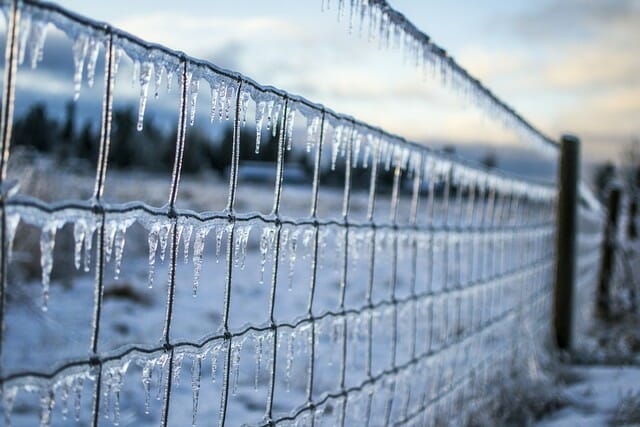Last Updated on May 17, 2022 by Grow with Bovees
Harvest mites, berry bugs, chigger mites, trombiculid mites — or whatever the name you know them by, chiggers are unwelcome everywhere! These beings may be microscopic in size but the pain and inconvenience they bring can be quite humongous.
The worst part? Due to the size of chigger mites, you won’t even know that you’re a victim of a chigger’s angry bite till the big, itchy bumps on your body beg your attention—and most specifically that of your fingernails.

Wanting to know how to get rid of chiggers is quite natural and understandable—here’s our guide on how to eliminate chiggers once and for all!
What Attracts Chiggers in the First Place?
Chiggers are found all over the country, thriving in heat, humidity, moist conditions, dense vegetation, leaf litter, tall grasses etc.
Apart from being attracted to these conditions, chiggers are attracted to the carbon dioxide that animals and humans exhale, gathering in wait in shaded spots to latch on to ankles and other suitable areas.
What Are Chigger Mites – Harvest Mites?
Chiggers – scientific name: Trombiculidae, aka; harvest lice, red bugs or harvest mites, are found in every state in the United States but are more of a nuisance in the southern and Midwestern states, aided by the constant heat and humidity.
Chiggers belong to the arachnid family (eight legged arthropods), which means that they’re related to spiders. Like spiders, they can’t fly and also have eight legs.
Chiggers are deceivingly colored, in warm tones such as red, orange, yellow & straw and, up close, resemble a cross between an extremely small spider and an extremely small crab. The red version should not be confused with clover mites, which are also red.

Chigger larvae emerge in their larval form from their shells about a week after they’re laid. The only parasitic form in the life stages of a chigger is the juvenile form/larvae which has six legs when in its larval stage, growing an additional pair once they mature into nymphs and adult mites. Only the larvae will feed on hosts.
Chiggers are barely visible, measuring merely 1/150th of an inch, excluding their eight legs, and while this means that they’re generally impossible to see with the naked eye (you really need a magnifying glass to make a positive identification), it’s certainly not impossible to feel their bite!
The juvenile forms of chiggers bore holes into the skin with the help of sharp, jaw like claws and, instead of sucking blood, like mosquitoes and bed bugs, chiggers have their fill of skin cells through the use of a narrow feeding tube that projects from their mouth, enabling them to inject enzymes contained in their salivary fluid.
These digestive enzymes then break down the host tissue/your skin cells, so they can suck them up as food.
This saliva, which dissolves skin, is the reason behind the painful welts left behind on your skin after chiggers burrow their way in.
This ability to inject enzymes into the host tissue through a feeding tube, is similar to that of mosquitoes, but used for a different reason. Mosquitoes use their feeding tube to inject a protein to stop blood clotting so that they can suck it out.
Any mammal that passes through their habitat is fair game to satisfy their feeding habits—these mites don’t have a very discriminating palate! Then, after they’ve had their fill from their host’s skin, they simply drop off.
There is an incorrect belief/common myth that chiggers stay attached, burrow into the skin and stay there, but that is most definitely not true!
As they are not actually very good biters due to their delicate feeding structures, they tend to go for thin skin such as that on ankles or wrists, or the skin inside folds of skin such as the groin areas or under the bra line.
Chiggers serve as food for a range of other species—birds, sugar ants, centipedes, beetles, spiders and other small creatures.
Where Do Chiggers Live?
These tiny pests call a variety of places home, but the largest chigger populations are most commonly found, in thickets of small trees, swampy areas, tall grassy areas, dense bushes, brambles, transition zones such as junctions between the forest and the grass and other thickly vegetated areas.
They thrive in warm, slightly humid weather, which means they’re a common sight in the lower Midwest and southern regions of the United States. Depending on your location, they may be active during late spring through to early summer or all year around.
That isn’t to say they’re only restricted to these areas—they happily make hay when the sun shines, emerging in other parts of the country, too, during the summer.
The only consolation, though, is that the larval stage is much shorter in areas where humidity and heat are not constant. They also prefer shaded spots, often grouping on low-hanging leaves or blades of grass in shaded areas.
Having said this, they don’t do well – or bite (!) at temperatures colder than 60 deg F (15.5 deg C).
Neither can they survive in areas hotter than 99 deg F (37.2 deg C).
How Do You Prevent Chigger Bites?
Chigger bites occur where human skin is exposed to chiggers.
It makes logical sense then to say that to prevent chigger bites you need to avoid chiggers.
However, it’s not necessary to restrict your outdoor activities in fear of these pesky mites—instead, use the following methods to combat chiggers while still enjoying your outdoor activity!
How To Treat Chigger Bites
The main symptom of a chigger bite is generally itching and a slightly raised pimple-like area/red welt on the skin. The itching increases over the few days following the initial bite.
The good news is that chigger bites are generally harmless to human skin and children often outgrow reacting to them.
A bite from a chigger nevertheless, can cause intense itching for those who are especially susceptible.
Fortunately, this intense itching is fairly easily treated with creams and ointments such as calamine lotion to reduce the itching & discomfort, soothe chigger bites and to speed healing.
As a self administered chigger treatment, you can apply a small amount of over-the-counter hydrocortisone cream, corticosteroid creams or calamine lotion to the affected area. (Don’t use hydrocortisone if you have sensitive skin or a skin condition, such as eczema.)
You can also make a paste of baking soda and water to use as a soothing cream.
The trick is to apply the cream or ointment as soon as possible after being bitten so that it can neutralise the enzyme and reduce itching, possibly even preventing the itching altogether.
When you consider that a bite from a chigger can continue itching for up to two weeks, it’s worth slapping that ointment on sooner rather than later!
It can also help to take an over the counter anti-histamine tablet and apply a cold compress while you wait for it to take effect. A cold compress will soothe the affected area.
Hot soapy water and hot baths are definitely not the answer, they’ll just increase the inflammation and discomfort.
Forget about using old wives tale remedies too, like nail polish or bleach, these are likely to cause more of a skin irritation than the chigger bite itself!
However, if you don’t have any cream or ointment to hand, you can certainly apply cool compresses or try a cold shower to get some relief. The main thing to try and do is avoid scratching.
Once you’ve been bitten, although chiggers burrow below the surface of the skin, it’s still important to clean the area around the site thoroughly with soapy water with a few drops of antiseptic added. This reduces the risk of infection caused by too much scratching. As previously mentioned; it’s important to try and avoid scratching.
So long as a secondary infection doesn’t set in, there are generally no long term complications from chigger bites, so it is also wise to apply some antiseptic cream especially if the skin has been broken due to scratching.
Although they are not generally known to transmit diseases, occasionally, chiggers can be infected with bacteria called Orienta Tsutsugamushi which causes a disease in humans known as scrub typhus or bush typhus.
As Bovees do not offer medical advice, we would recommend that you don’t resort to home remedies alone if you experience any of the following symptoms along with your bite symptoms; fever, headache, body aches and sometimes areas of rash as opposed to individual bites.
In that case, rather seek health solutions from a doctor who can provide medical advice diagnosis.
There are also various publications available if you would like to study the topic to a greater depth;
First Aid for Bites and Stings Medically reviewed by Deborah Weatherspoon, Ph.D., R.N., CRNA
Bug Bites and Stings Medically reviewed by Cameron White, M.D., MPH
How to Prevent and Treat Chigger Bites By Amanda MacMillan Medically Reviewed by Stephanie S. Gardner, MD
Everything You Should Know About Papular Urticaria Medically reviewed by Sarah Taylor, MD, FAAD
“Chiggers.” Missouri Department of Conservation
How to Treat Chigger Bites Medical Author: Melissa Conrad Stöppler, MD Medical Editor: Charles Patrick Davis, MD, PhD Reviewed on 7/28/2020
Prevent Chiggers: Wear Protective Clothing
Chiggers attach to exposed skin by piercing the skin cells, so an easy solution to that is to wear chigger repellent clothing such as long sleeves and long pants with the pant legs tucked into your socks when walking through tall grass.
Even if you wear long sleeves, it is also a good idea to wear gloves and tuck the sleeves into the top of the gloves. Wrists, having particularly thin skin, are prime targets for chiggers.
Apply bug spray to exposed areas to avoid chigger bites.
Wash clothing as soon as possible after it has been worn outdoors in a potential chigger area, such as grassy areas.
Washing clothing is especially important to prevent chiggers from setting up home in your home.
Once your outdoor activity is over, and you have removed the potentially contaminated clothing, it is also a good idea to take a hot shower and wash off any lingerers that may be clinging to your hair
Chigger Repellents: Plant-Based Lemon Eucalyptus Insect Repellent
Using strong insect repellents is one of the easiest, most effective ways to prevent bites by deterring the culprits, chiggers included.
DEET-Free Insect Repellent
Repelling chiggers deet free is better for human skin.
This DEET-free insect repellent does the trick, repelling everything from mosquitoes to chiggers—quite the wholesome package if you’re having to deal with a variety of pests in your house and garden!
The major ingredient for repelling chiggers in this insect repellent is lemon eucalyptus oil, the sole plant-based active ingredient that the Center for Disease Control recommends.
The oil repels insects for up to six hours, creating an effective barrier that’s neither sticky nor greasy on the skin. You can also spray it all over your clothes to repel chiggers, before heading out, but pay particular attention to the places where chigger bites occur most commonly, such as ankles and lower legs.
Other essential oils that can be used as chigger repellents are tea tree oil, eucalyptus, thyme and lemon grass.
The smell is also quite refreshing, unlike chemical pesticides.
Plant Marigolds
Many people use marigolds for beneficial effects in gardening, and keeping chiggers away is one such use for marigolds. Plant them wherever you can!
Does Diatomaceous Earth Kill Chiggers?
Yes, diatomaceous earth kills chiggers, it can eliminate a chigger infestation.
The solution to many pest problems, diatomaceous earth (scientifically known as diatomite) is made up of fossilized diatoms and works by sucking dry the insects. The substance kills chiggers by absorbing the waxy coating found on the exoskeletons of insects and damages their shells. It is kind of a natural way of killing chiggers in your yard!
Food grade diatomaceous earth is also safe (which most chemical insecticides can’t offer)—it doesn’t affect pets or humans.
Application, by sprinkling or dusting it across affected areas on your lawn, can help banish chiggers by damaging the exoskeleton of adult chiggers. As a bonus, you’ll also be bidding adieu to any flea, cockroach and tick problems. But it is important to remember that diatomaceous earth will also harm beneficial insects, so use it with caution.
While you can just attack specific spots, a broadcast application all over the area is a better idea.
The horrible thing about chiggers is that they can migrate indoors, but the great thing about diatomaceous earth is that you can also use it indoors—you can lightly dust the substance around windows, doors and other entry points, as well as your couch, to target adult chiggers and thereby eradicate chiggers inside your home.
How to Get Rid of Chiggers Outside on the Lawn
There are many ways on how to get rid of chiggers and fleas in your lawn so that you can enjoy the great outdoors, such as:
- Pulling out Weeds: Chiggers like thick vegetation and tall grasses. By removing weeds, you’re reducing the amount of vegetation that these pests can call home. Make sure to remove overgrown, unnecessary, weedy areas.

- Mowing the Lawn: Another way to eliminate dense vegetation is to cut your grass frequently.
- Chiggers don’t just like dense vegetation—they also like tall vegetation.
- Getting busy with your lawn mower and keeping your lawn mowed reduces both.

- Cold Climates: While this isn’t in your control, it helps to know that chiggers hate the cold. They can’t survive frosts, so the cold naturally gets rid of your chigger problem for you. After that, you can continue other maintenance practices to prevent them returning.

- Yard Treatments: Keep a check on the build up of leaf litter in your yard and also on areas of overgrown vegetation. If the chigger problem gets out of hand, you can always turn to professional pest control services to treat your yard with insecticides.
- However, if you don’t want to go all guns blazing yet, you can purchase a repellent or sulfur powder (or sulfur pellets) yourself (stay away from these if you have pets, though). All yard remedies should be started before late spring or early summer, which is when chiggers really get going.
Apart from the above, it also helps to wear long-sleeved clothing and pants with the pant legs tucked into your socks, when you go out and while treating your yard for chiggers, preferably sprayed with your chosen repellent.
After you get home from your outdoor adventures, shower—hot water and soap help dispense with any chiggers that may still be latched on to you.
Wash your clothes—put them into the washer as soon as you get home, preferably, to avoid giving the chiggers a tour of your home and risking them migrating to these areas.
It also helps to stick to hard surfaces instead of grassy areas and skip shaded spots. Strong odors also help keep chiggers away.
Things You’ll Need To Get Rid Of The Red bugs
Here’s a list of things you’ll need for your chigger control exercise:
- Repel: Plant-Based Lemon Eucalyptus Insect Repellent
- Diatomaceous earth
- Full-sleeved clothing, wear long pants tucked into your socks and tops made of tightly-woven fabric to minimize areas of exposed skin
- Sulfur powder (if you’re choosing this method as an insect repellent)
- Lawnmower or shears and pruners
- Home made weed killers
A combination of the aforementioned items should go a long way in helping you stay chigger protected. Apart from that, some suggestions we’ve made earlier will help you prevent them from being anywhere near you in the first place, and if you do encounter chiggers in your yard, you know exactly how to get rid of them now!
